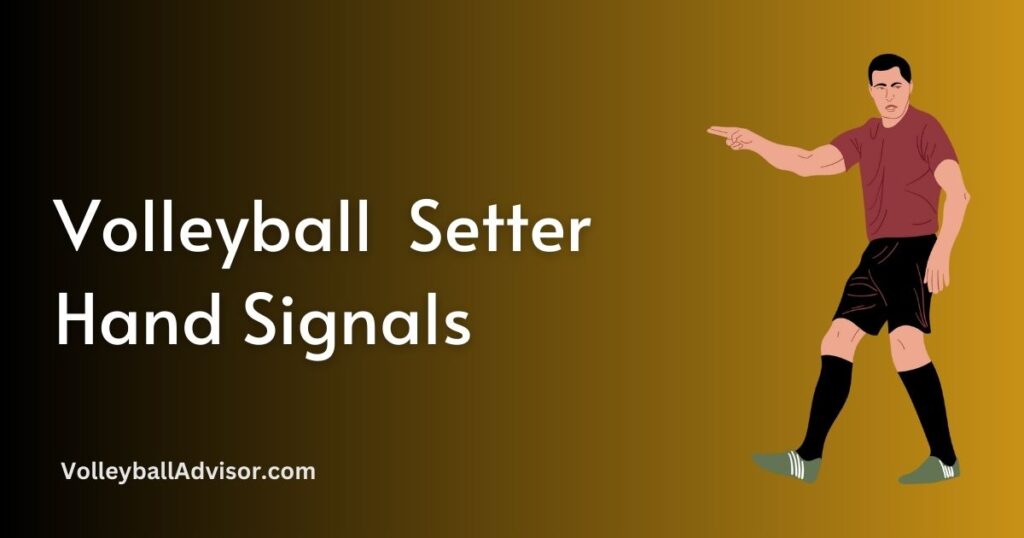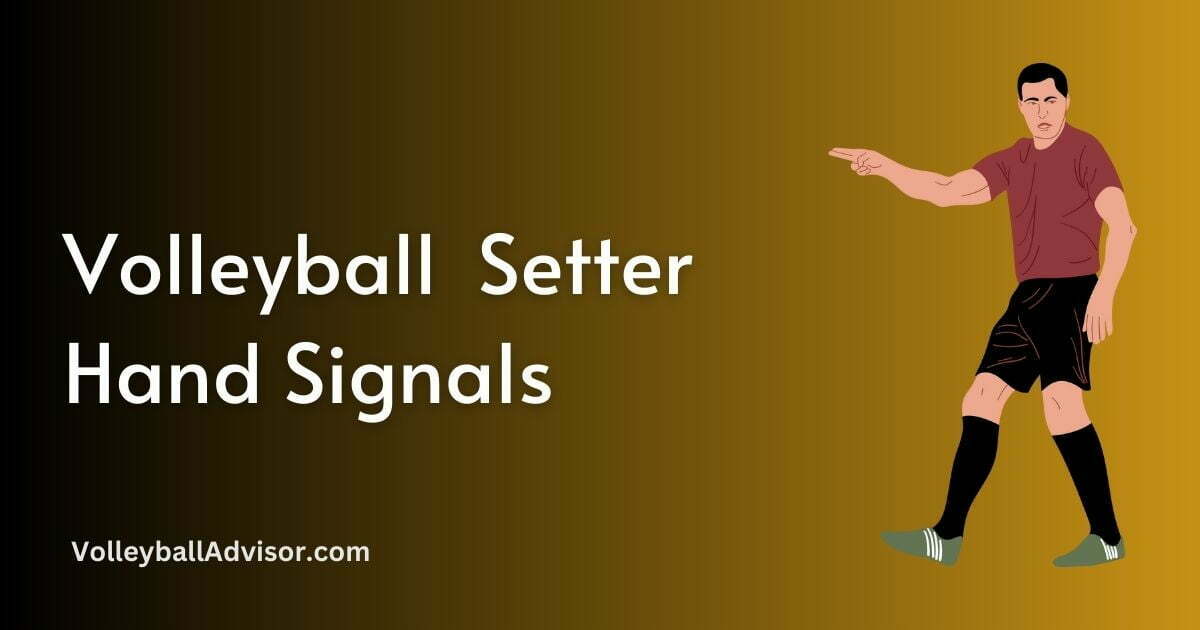Volleyball is a dynamic and fast-paced sport that demands seamless communication and teamwork among players.
In the heat of the game, verbal communication can be challenging, and that’s where hand signals come into play.
Setters use hand signals to discreetly convey their intentions to their teammates, helping coordinate plays and maintain a strategic advantage over their opponents. Before starting, you should know about:-
Volleyball Setter Hand Signals
Hand signals play a vital role in improving communication between setters and hitters, allowing them to execute plays efficiently and effectively.

By using hand signals, setters can communicate the type of set they intend to make, enabling hitters to adjust their approach and timing accordingly.
This non-verbal communication system helps maintain a level of secrecy, preventing the opposing team from anticipating the play and positioning their defense accordingly.
Different Types Of Volleyball Setter Hand Signals
Volleyball hand signals can be grouped into different categories, based on the type of attack and the location on the court. Here check a list of the top 10 best setters in the world.
In this comprehensive guide, we will explore the various hand signals used for left-side attacks, right-side attacks, middle attacks, back-row quick attacks (BIC), and combination plays.
Mastering these hand signals will help players improve their on-court communication, leading to more effective and successful plays.
Left Side Attack Hand Signals
The left-side attack hand signals are used to coordinate plays on the left side of the court, usually involving the outside hitter. They include:
4
Indicated by holding up 4 fingers, this is a traditional high ball set to the left-side attacker.
The 4 set allows the hitter to have more time to approach and jump, making it ideal for highball situations.
Hut
Indicated by making a slashing motion across the chest, this is a slightly faster tempo and lower arching outside set.
The hut set requires the hitter to be quicker in their approach, giving them an advantage by catching the blockers off guard.
Go
Indicated by making a gun symbol with the index and middle fingers and thumb, this is an even faster “2nd step” tempo outside attack.
The go set relies on precise timing between the setter and the hitter, as the hitter should be on the second step of their approach when the setter is contacting the ball.
32/Rip
Indicated by making an arch with the hand, this is a shorter and quicker outside high ball set between positions 4 and 3.
The 32 or rip set provides an opportunity for the hitter to attack from a slightly different angle, making it more challenging for the opposing blockers to defend against.
A (Back Row Attack)
Indicated by drawing a line over the upper chest near the right shoulder, the “A” ball is an extremely uncommon back-row attack from the back/left side of the court (position 5).
It’s the mirror opposite to a D. This attack requires precise timing and a powerful approach from the back row hitter, as they aim to generate enough force to penetrate the opposing team’s defense.
Right Side Attack Hand Signals
Right-side attack hand signals are used to coordinate plays on the right side of the court, typically involving the opposite hitter. These hand signals include:
Back 2
Indicated by holding up your pinky and ring finger, the “back 2” is a set directly behind the setter to the right-side attacker. The ball should be set in between positions 3 and 2. This attack can be effective in exploiting gaps in the opposing team’s defense.
5
Indicated by holding up 5 fingers, the “5” set is a fairly high ball set out to the sticks on the right side of the court. The 5 set allows the opposite hitter to attack from a higher position, making it challenging for the opposing blockers to defend.
Red
Indicated by making a closed fist, the “red” set is a lower, faster tempo version of a 5. This set requires the hitter to be quick in their approach and demands precise timing between the setter and the hitter, making it difficult for the opposing team to anticipate the attack and position their defense accordingly.
D (Back Row Attack)
Indicated by drawing a line over the upper chest near the left shoulder, the “D” attack is a right side attack from the back row, usually run by the opposite hitter. This attack can be an effective option for teams looking to diversify their offensive strategy and catch the opposing team’s blockers off guard. By executing a well-timed back row attack, the hitter can exploit gaps in the opposing team’s defense and potentially score points.
Middle Attack Hand Signals
Middle attack hand signals are used to coordinate quick attacks through the center of the court, typically involving the middle blocker. These hand signals include:
1
Indicated by holding up 1 finger, the “1” set is a standard quick set to the middle blocker in front of, but close to the setter.
This attack aims to exploit the opposing team’s defense by executing a fast, low set that’s difficult to block.
Push 1
Indicated by flexing your index finger, the “push 1” set is a slightly off-center quick set (further to the left than a typical 1).
This variation can be effective in creating confusion for the opposing team’s blockers.
3/Shoot
Indicated either by holding up 3 fingers or by making a gun symbol with your index finger and thumb, the “3” or “shoot” set is a quick attack pushed even further to the left of the setter than a Push 1.
This set requires exceptional timing between the setter and middle blocker to execute successfully.
Back 1
Indicated by holding up your pinky finger, the “back 1” set is identical to a “1” except that it’s run behind the setter and not in front of them.
This attack can catch the opposing team’s blockers off guard, as they may not anticipate the change in direction.
Slide
Indicated by making a shaka sign, the “slide” attack involves the middle blocker beginning in the middle or left of the court but running to the right side to hit the ball.
The ball should be set 3-4 feet above the net, and the attacker will usually jump off one leg for a slide.
This play requires good coordination between the setter and the middle blocker and can effectively confuse the opposing team’s defense.
2
Indicated by holding up 2 fingers, the “2” set is a high ball set to the front middle of the court. The lower/quicker version of this set is known as a meter ball.
This set provides a different attack angle for the middle blocker, making it more challenging for the opposing team to defend.
Pipe (Back Row Attack)
Indicated by drawing a line down the middle of your chest, the “pipe” attack is a back row attack through the center of the court.
This attack can be an effective way to diversify the offensive strategy and exploit gaps in the opposing team’s defense.
B (Back Row Attack)
Indicated by drawing a line down the middle of your right chest muscle, the “B” attack is a back row attack taking place between positions 6 and 5 – it’s right in between an “A” and a “pipe”.
Although it’s a fairly uncommon attack, the “B” ball can catch the opposing team’s defense off guard when executed well.
C (Back Row Attack)
Indicated by drawing a line down the middle of your left chest muscle, the “C” attack is a back row attack taking place between positions 6 and 1 – it’s right in between a “D” and a “pipe”.
Similar to the “B” attack, the “C” ball is a very uncommon attack but can effectively confuse the opposing team’s defense when executed with proper timing and coordination.
Back Row Quick Attack (BIC)
The back row quick attack, also known as a BIC, is a faster tempo and lower version of the standard back row attacks.
This type of attack can increase the offensive options for a team and make it more difficult for the opposing blockers to anticipate and defend against the attack.
BIC Signal and Its Usage
The BIC signal is made by creating a fist and flashing your thumb like you’re lighting a lighter.
The setter uses this BIC signal while making the typical back row play signal (A, B, C, D, pipe) to indicate the faster tempo.
For example, a BIC pipe would involve the setter making the pipe signal and adding the BIC signal to indicate that the pipe attack should be executed at a faster pace.
This play requires exceptional coordination and timing between the setter and the hitter to be successful.
At the high level, the BIC concept doesn’t really exist because it’s simply a given that back row attacks are run quickly. Top volleyballers would, therefore, simply refer to a BIC pipe as a pipe.
Tips for Effective Hand Signal Communication
To make the most of hand signals in volleyball, it’s essential to ensure that your communication is clear and effective. Here are some tips to help you achieve that:
A. Ensuring Clear and Visible Signals:
Make sure that your hand signals are easily visible to your teammates. Hold your hand up and away from your body when signaling, so your teammates can see your fingers and hand gestures without any obstruction.
B. Consistency in Signal Usage:
Stick to the same set of hand signals throughout the game and the season to avoid confusion. Make sure that everyone on the team is familiar with the chosen set of signals and uses them consistently.
C. Practicing with Your Team to Build Familiarity:
Spend time practicing hand signals during team training sessions to build familiarity and coordination. The more your team practices using these signals, the better they’ll be able to understand and execute plays during matches.
Conclusion
Mastering hand signals in volleyball can have a significant impact on a team’s performance.
It improves communication, allows for strategic plays, and can create confusion for the opposing team.
By ensuring clear and consistent use of hand signals and practicing them regularly with your teammates, you can build a stronger, more cohesive team that excels on the court.
Remember, continuous improvement and communication are key to achieving success in volleyball. By focusing on these aspects, your team can not only execute complex plays with ease but also adapt to the challenges that arise during matches.
